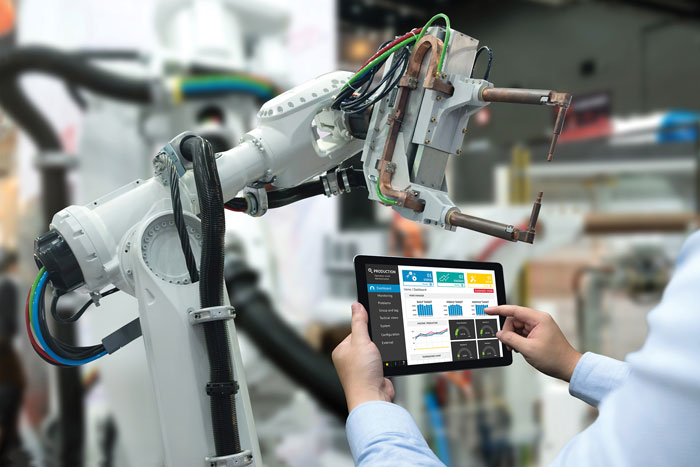
Top 5 industrial automation trends in 2020: Eric Cosman, ISA
January 6, 2020
By Eric Cosman
 Photo: Zapp2Photo/Getty
Photo: Zapp2Photo/Getty In the upcoming issue of Manufacturing AUTOMATION, we asked several industry experts to share their top five trends in industrial automation for the coming year.
It’s a new decade – read on for what Eric Cosman at the International Society of Automation says manufacturers should expect in 2020. Looking for more insights? Read the top 5 trends from ARC Vice-President Craig Resnick and A3 President Jeff Burnstein.
Eric C. Cosman, ISA
Eric C. Cosman is the 2020 president of the International Society of Automation (ISA), which was founded 75 years ago. He is a retired engineering solutions architect with The Dow Chemical Company in Michigan. His responsibilities included system architecture definition and design, technology management and integration planning for manufacturing systems globally.
Even in recent years, the practice of industrial automation – made up of people, process, and technology – has changed significantly. The most important and impactful trends that ISA sees on the horizon for the coming years aren’t new, and in some cases, they aren’t driven by technology. While industries traditionally focus on technology trends, it is perhaps even more important – now, more than ever – to focus on the “people” and “process” elements.
Particularly in political discourse, it’s common to associate automation with negative economic consequences. It’s easy for a bystander to associate the word “automation” with faceless machines that take jobs from friends and neighbours, resulting in a generally negative view of the profession. Professional societies like ISA must take every opportunity to counter this impression through awareness, outreach and advocacy. Automation has enabled life-changing progress in so many areas –the medical devices that millions rely on; the water we drink; the power we use. If we are going to attract the next generation into the profession as part of the larger STEM imperative, we need to tell our stories.
1. Workforce development techniques
Much has been said and written about the “greying” of the workforce and the challenges faced by industry as members of the baby boomer generation retire. We are approaching the peak years of this trend, and while the challenge is real, so is the opportunity.
Senior members of the automation profession should take every opportunity to establish mentoring relationships with their younger colleagues. This preserves valuable experience and expertise, and it offers the baby boomer generation a chance to give back and stay engaged.
More attention must be given to tools, techniques and processes for effective knowledge transfer while respecting the fact that younger professionals can bring different perspectives to solving common problems. Every organization should have a strategy for adapting and optimizing their environments to leverage one of their most critical assets – their people.
2. Using digital transformation efficiently
While digital transformation has been cited for years as an emerging trend, this time, we’re not referring to the technology itself as much as we’re referring to our ability to use it wisely. The term “digital transformation” has become so pervasive in recent years that it has become something of a meme. As is so often the case with memes, interpretation and definition is dependent on context.
In the case of automation, it generally refers to the application of digital technologies to increase the value of industrial processes. Unfortunately, new technologies often emerge much faster than the level of understanding of how to best apply them. Asset owners are faced with significant challenges in determining the current state of their processes and equipment, but also in understanding how to select the technologies that have the highest potential for increasing value with minimal cost and disruption.
Automation professionals must supplement their focus on what technologies are available with increased emphasis on understanding current processes and determining the best choices for each situation. Many asset owners do not have the resources or expertise to do this for themselves, which increases dependence on expert consultants.
3. Big data and analytics applications
Automation professionals have experienced a shift: from a world where data collection was costly and time consuming, to one where the sheer amount of freely available data is almost impossible to deal with. Data has gone from being expensive to being essentially free, and the new challenge is selecting the data that can significantly improve operational efficiency and value.
In many cases, the approach has shifted from using process analysis and first principles models to more empirical methods. Beginning with the use of tools such as neural networks, this has evolved to increased use of analytical tools to develop empirical models for process improvement. Again, the trend on the horizon isn’t necessarily the development of new technology; it’s the application and optimization of the technology we’ve already developed.
4. Supply chain management
Automation systems were originally custom-built for a particular purpose, using specialized tools and technologies. These have now been replaced with complex systems that are assembled using commercial off-the-shelf technologies in areas ranging from operating systems and databases to hardware and networking platforms.
Much of the complexity of these systems is introduced in the system integration phase of a project. The result? Asset owners own and operate systems made up of products and technology that they may not fully understand. While it is unrealistic for them to have security, operating system, and network experts in their operating facilities, it is essential for them to understand what components are used in their solutions, how and by whom they were developed, the requirements and constraints used in the design process, and how components were assembled into complete systems.
They must understand the solution life cycle from conception and development through integration, installation, operation and maintenance. This requires close partnerships with suppliers and integrators that include clear definition of responsibility and accountability for all parties.
5. Moving from standards to practices
Industry standards have long provided a means of defining the essential requirements and operational characteristics of various technologies. They are often of most interest to suppliers, who wish to develop their products to meet the broadest set of requirements.
Unfortunately, defining how a technology must operate and the performance to be achieved is not enough. While standards are often the basis for describing what is referred to as “commonly accepted engineering practice,” they must be supported with practical examples, guidelines and practices that allow integrators and asset owners to apply the technology.
Standards development organizations must expand their offerings to include practical guidance aimed at these stakeholders, which in turn leads to broader acceptance and adoption of the standards.
Advertisement
- Energy efficiency: Wireless lighting control systems in the factory
- Window manufacturer fined $90K for worker injury in second offence
